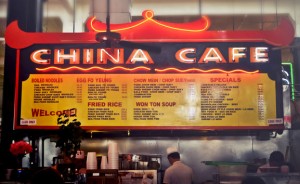Grand Central Market brims with new vendors, food
Grand Central Market, located downtown at 317 S. Broadway, is a charming landmark with an innovative edge. Since it opened in 1917, the market has represented the diverse, delicious flavors of Los Angeles and catered to an ever-changing population. Patrons can find everything from fresh banana leaves to artisanal chocolates.

Mix of old and new · As new restaurants are introduced to Grand Central Market, stores like China Cafe stick to their traditional values and years old recipes to maintain happy regular customers. – Photo Courtesy of Grandcentralmarket.com
Since its heyday in the 1920s, Grand Central Market has changed with downtown’s shifting landscape to include green grocers, spice vendors and specialty food vendors. The market currently hosts more than 20 vendors and is in the process of expanding.
The newest addition, McConnell’s Ice Cream, started scooping in July. Their Grand Central Market location is not their first. The Santa Barbara based company has two additional parlors in its hometown and one in Ventura, California. As Chris Farber, director of business development for Grand Central Market, warned, “their ice cream is dangerously good.”
Farber’s role in developing the market gives him access to a diverse array of flavors on a daily basis, which he says allows him to see the passion vendors have for the food and the sense of community the market offers. “People cross paths with each other through food. In the mixing ground of L.A., Grand Central Market has a unique role.”
Unlike other corners of the city, the market appeals to people from many different backgrounds. Farber explains that the market’s founder, Ira Yellin, created the market to foster a sense of community. “It allows Angelenos to rub shoulders in ways that are very rare in L.A.”
In addition to attracting a trendier crowd with shops such as G&B Coffee, Better Booch and The Oyster Gourmet, Grand Central Market is also home to ethnic eateries and food purveyors. Some, such as China Cafe, famous for its wonton soup, have been in operation since the 1940s.
Although each stall has its own personality, the market still manages to feel cohesive. The diverse array of options make the market an ideal place to dine with a large group. Friends can share a meal while sampling cuisines from across the world and later peruse the aisles for specialty food products.
Newer patrons are often become repeat customers and experience the full flavors of the market on subsequent trips. “The influx of new businesses have also brought new people to the old businesses — everyone benefits,” Farber said.
Chef David Tewasart, owner of the Thai eatery Sticky Rice, feels the market has evolved noticeably since his restaurant opened a little over a year ago. “Sticky Rice was the first of the second wave of incoming restaurants — we’ve had a front seat to change.”
The influx of downtown residents has expanded the market’s clientele and increased demand for casual food options. “The demographic used to be more homogeneous, now it’s packed every Saturday and Sunday — we also do a big lunch rush — it’s overall a more mixed crowd,” Tewasart said.
Although recent additions include fine food purveyors, such as Belcampo Meat Co. and DTLA Cheese, with limited selections of products, the market retains a welcoming atmosphere. “These people really know their products and are super friendly. The market offers specialty and niche food but in a casual atmosphere — it’s still very accessible — we offer a varied price point,” explains Farber. The market fosters a sense of community between vendors, patrons and the downtown community.
Most stalls have long counters and barstool seating, encouraging customers to linger over their meals and have a taste of downtown Los Angeles. Ample seating and indoor-outdoor spaces also provide a welcoming, casual atmosphere and encourage conversation. As Valerie Gordon, the owner of Valerie Confections says, “the market is friendly, homey and casual.” Even though she offers a full line of artisanal desserts, she feels the location “is very approachable — there are always samples.”
The market also hosts dinner and movie nights at the adjacent Million Dollar Theatre and has plans to expand partnerships with local media outlets and offer additional movie screenings, books signings and lectures. “We’re trying to create a community place — people come for the food and stay because it’s a cultural destination,” Farber said.
In addition to these programs, Grand Central Market recently expanded its hours and now stays open for dinner Thursday through Saturday nights. Aside from increasing foot traffic, these extended hours allow the market’s eateries to offer late night and diner fare. As Gordon explained, “we are excited to integrate evening components into our menu — it’s a constantly evolving process sparked by customers’ desires and the creative process.”
The market is poised to become downtown’s prime market-style dining location. According to Chef Tewasart, “Grand Central Market is representative of the city as a whole — it’s diverse, its timing is good, it’s evolving — the market will always be an L.A. thing.”
With its extended hours and plans for expansion, the market is adding flavor and flair to the L.A. dining scene. Grand Central Market’s convenient location, culinary variety and reasonable prices truly allow customers to have their cake and eat it too.

